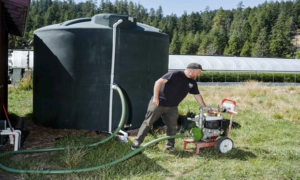
Shutterstock
Since I moved to our firm’s Los Angeles office, I’ve been getting calls nearly non-stop from existing and potential clients looking to take advantage of California’s soon-to-be highly regulated medical cannabis marketplace under the Medical Cannabis Regulation and Safety Act (“MCRSA“). Nearly all of these callers are already behind when it comes to what they need to know and do to secure a California medical cannabis license in 2018.
Even though California’s rules are still in their initial draft form, they provide great insight into what to expect from the future adopted rules. Surprisingly though, few cannabis stakeholders interested in California’s massive medical cannabis industry have read the rules and this means most have no concept of how important local law compliance is.
The following is the minimum you should know for positioning yourself for a California medical cannabis license:
- Priority review. Turns out priority review will actually net you a temporary state license to operate this fall, but you can only get priority review if you were “in operation and in good standing with [your] local jurisdiction by January 1, 2016.” What this really means is that a good number of pre-existing non-profit collectives are going to get first dibs on temporary licenses while all other license applicants will have to wait until January 2018 to begin receiving their licenses. Many of these pre-existing non-profits want to know whether they can go for-profit now and still receive priority review from the state since part of the analysis of priority review is whether your “ownership or premises are currently the same” as they were on or by January 1, 2016. Though existing operators need further clarity from the state on the non-profit to for-profit transition in the context of priority review, new operators can likely forget priority review status altogether.
- Prop. 215 is still alive and that’s a problem for for-profit cannabis companies. I am always getting asked whether California allows for-profit cannabis companies now, and the answer is still “no.” Though for-profit entities are allowed to be license applicants under the MCRSA, if you are servicing groups of patients now, the State still encourages you (from a 2008 State Attorney General memo) to form a non-profit collective (if you’re going to form an entity at all) because neither the MCRSA nor the Adult Use of Marijuana Act repealed Prop. 215, which prohibits for-profit sales of medical cannabis. In addition, many local ordinances still require “commercial cannabis activity” to take place within non-profits. The complicating factor is that some California cities and counties are allowing for-profits to apply for local permitting right now. This, combined with the fact that the state is going to allow for-profit applicants, has led some operators to bite the bullet and go for-profit ahead of state licensing in spite of Prop. 215. These operators are betting that the risk of state and local law enforcement interference is lower if local governments are allowing for-profits, and they don’t want to take the chance that the state may not allow for-profit mergers or conversions after state licensing. Since most local ordinances do not allow for transferring cannabis permits after-the-fact, deciding now whether to use a for-profit or non-profit is an immensely important decision.
- Local law is king (and always will be in California). The MCRSA requires you show you have local approval to receive a state license. If you don’t have local approval and you try to open despite a local ban or even if you are simply operating under a local government’s tacit approval without any formal recognition, you’re going to suffer in California. California’s cities and counties seemingly constantly change their minds and their laws on what MCRSA businesses and which operators they’re going to allow within their borders (for example, check out our San Fransisco office’s reports here and here on what happened in Marin County). And the local regulation that does exist is rife with zoning limitations, intense deadlines, high fees, property buffers and setbacks, and all kinds of operational standards.
- You can’t manufacture just anything. Many do not realize that when California cannabis regulation hits, product choices immediately will get taken away from cannabis manufacturers and consumers because of consumer safety issues and policy choices. Section 40300 of California’s cannabis manufacturing rules sets forth all products that will be outlawed if these rules are adopted. Should this version of the rules be adopted, products that would be barred include cannabis-infused alcoholic beverages, nicotine, or caffeine; any canned cannabis product; any juice; cream or custard-filled pies; pies or pastries which consist in whole or in part of milk or milk products, eggs, or synthetic fillings; meat-filled pies or pastries; dairy products of any kind; meat products of any kind; and seafood products of any kind. Most regulated states have gone further than California when it comes to banning entire product lines — it’s now nearly impossible to find cannabis gummy bears in many cannabis regulated states. All of this means that creative food makers and infusers are likely to be mostly sidelined from California’s cannabis game.
- Ownership and investment. California’s medical rules do not contain any hardcore residency or financial minimums or liquidity requirements (yet) for owners and financiers. Under the initial rules, the basic background and corporate information submissions to the state are pretty much identical across license types. Each license applicant will need to submit to the state required background information on all owners. An “owner” is the CEO or any person or entity within a publicly traded company that has, in aggregate, greater than a 5% ownership interest and, for all other business entity applicants, “owner” means any individual who has, in aggregate, greater than a 20% ownership interest — excluding the ownership of a security interest in, lien on, or any other encumbrance of the business entity applicant. And if there’s a business that has an ownership stake of greater than 20% in the entity applying to the state for a cannabis license, its CEO and all of its directors will be considered owners. Lastly, an individual is considered an owner if he or she participates in directing, controlling, or managing the applicant, which includes “discretionary powers” to, among other things, direct and/or control the hiring and firing of personnel, contracting for the sale of goods on behalf of the applicant, and making policy decisions on behalf of the applicant. All owners must be disclosed to the state, along with their stated ownership interest in the applicant. All owners also must disclose if they (or their spouse) have a “financial interest” in any other licensee applicant, which includes any “investment in a commercial cannabis business, a loan provided to a commercial cannabis business, or any other equity interest in a commercial cannabis business.” For now, only retailers, distributors and transporters will face the highest level of financial scrutiny as California is going to require that these entities submit the following:
- A list of funds belonging to the commercial cannabis business held in savings, checking, or other accounts maintained by a financial institution;
- A list of investments made into the commercial cannabis business; and
- A list of all gifts of any kind given to the applicant for its use in conducting commercial cannabis activity.
Note though that no California rule prohibits out-of-state companies from applying for California cannabis licenses so long as they are registered to do business in the State of California. In other words, California’s medical cannabis industry is going to be open to out-of-staters and even to companies based outside the United States. Needless to say, many out of state and even out of country companies are in the midst of preparing to do cannabis business in California.
- Can I flip my license? No, but there’s likely a catch. California has made clear in its initial rules that its medical cannabis licenses are not transferable — and most local governments are not going to allow for transferring cannabis permits either. What this has meant in other states and what it likely will mean in California as well is that even though you cannot sell your cannabis license as personal property, you can sell the company that holds those licenses as part of a membership unit or a stock purchase and sale. I have little doubt that there will be a large and healthy market for people selling their licensed cannabis businesses right after licensing, and questions of sufficient due diligence, valuation, and the types of purchase and sale agreements that need to be in place will become hot topic issues.
- Prohibitions on vertical integration and licensing limitations. People forget that California’s initial rules stem from a statute, and that statute sets the baseline for the rules. In the MCRSA, we have a deliberate prohibition on combining certain types of licenses, and people need to keep those restrictions in mind as they decide the licenses they will seek, especially when local laws come into play. Under the MCRSA, a license applicant can hold up to two licenses in separate categories as follows:
(1) Type 1, 1A, 1B, 2, 2A, or 2B licensees may also hold either a Type 6 or 7 state license.(2) Type 6 or 7 licensees, or a combination thereof, may also hold either a Type 1, 1A, 1B, 2, 2A, or 2B state license.(3) Type 6 or 7 licensees, or a combination thereof, may also hold a Type 10A state license.(4) Type 10A licensees may also hold either a Type 6 or 7 state license, or a combination thereof.(5) Type 1, 1A, 1B, 2, 2A, or 2B licensees, or a combination thereof, may also hold a Type 10A state license.(6) Type 10A licensees may apply for Type 1, 1A, 1B, 2, 2A, or 2B state license, or a combination thereof.(7) Type 11 licensees shall apply for a Type 12 state license, but shall not apply for any other type of state license.(8) Type 12 licensees may apply for a Type 11 state license.
In addition, the cultivation rules contain strict ownership restrictions on Type 3 (medium cultivation) licenses. Unless a person has a Type 10A Producing Dispensary license, that person shall be limited to one Medium Outdoor, or one Medium Indoor, or one Medium Mixed-Light license. The 10A is limited to no more than three dispensaries and all cultivators are limited to a maximum of 4 acres of plant canopy in total.
- Medical and recreational are not the same. Though the MCRSA and the AUMA have a lot in common they also have notable differences, including different models on local approval, residency, vertical integration, and distribution. The differences between the MCRSA and AUMA are highlighted by the fact that though some local governments are embracing medical cannabis, they are rejecting adult use cannabis commercial activity at the same time. Should Governor Brown’s trailer bill pass this summer, those differences will become moot and California medical cannabis will become much more business friendly. Until then though, cannabis stakeholders need to realize the differences between these two laws and plan accordingly. For now, you can still undertake both medical and recreational cannabis operations so long as they are completely separate and not commingled in any way.
- Location, location, location. Securing viable real estate for your California cannabis business is going to be one of the toughest pieces of the regulatory puzzle. The initial regulations make clear that you will need to show you have a right to use some piece of real property for your commercial cannabis use and the owner of this property is aware of this. For local law compliance, you will need to have that real estate ready to go anyway and, with some of the deadlines being imposed by local governments, you may be in a serious race to find a viable property that fits all local and state buffer requirements and all applicable zoning laws (and that won’t attract the wrath of any NIMBYs). Given that many landlords are still gun-shy on cannabis leases (in large part because of federal law and asset forfeiture), you better start looking for your viable property now since it could takes months to locate and lock it down.
- Cannabis is still federally illegal. All too often investor clients bring us a Private Placement Memorandums or a Confidential Information Memorandum for a cannabis investment in California that nowhere mentions the risk of federal law enforcement or even that cannabis remains federally illegal. Just because most U.S. states have legalized medical cannabis and eight states have fully legalized cannabis, it doesn’t mean a thing under federal law. Yes, we have the appropriations riders that should work to protect state-law compliant MMJ operators from facing shutdown by the Feds, but if Congress ever fails to renew those riders, even that protection will go out the door. And those riders never did nor do they now apply to adult use cannabis operators. With notorious pot-hater Jeff Sessions as our country’s Attorney General, with a Cole Memo that can change or go away at any time, with a lack of access to banking, and with the negative tax impacts of 280e, ignoring federal illegality is a mistake in pretty much any context.
Link – Cannalaw




































